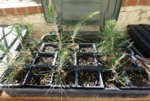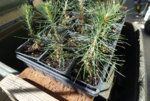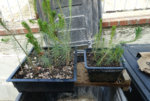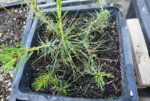RobertB
Chumono
These look huge!
LOL I forgot to start soaking them yesterday...
Is the soaking/scarifying process done before the cold stratification or after?
Understood. Thought the hot water was used to weaken the outer shell of the seeds, thus scarifying it in more simplistic way. Thanks for the explanation.Soaking is done before cold stratification. The term scarifying usually refers to a process that includes either physically scratching/scraping the outer seed layer, or using acid to dissolve it. We don't use scarification on pine seeds, but I have used it on other seeds (like Texas Ebony for example).
Thought the hot water was used to weaken the outer shell of the seeds, thus scarifying it in more simplistic way.
No one has mentioned that JBP and Scots Pine can be sown right out of the cone and do not need stratification, JWP is another story as well and most other five needle Pines including Bristle Cone Pines.
Yes, actually, hot water is another scarification process that I failed to mentionBut in the case of JBP we don't use hot water (or at least I didn't)... just any room temperature water out of the tap.
Yes. I'm not wholly convinced that I couldn't have just tossed them in some soil, watered them, and set them outside. In the case of the original BT article, the grower used cold dry stratification (storing the seeds over the winter in a dark, cold, dry place) and then a 3 day soak in the spring prior to planting - discarding the seeds that didn't sink.
The 30 day cold stratification instructions were included in a number of the seed packets I received, so to err on the side of safety, I used that timing. What I should have done is to directly plant some (without cold stratification) and see if there was a difference in germination rates.
Did some Fall maintenance (weeding, etc) on the seedlings so I thought I would post some photos.
Here is what the cuttings look like. I have four trays that are more or less like this. Huge disparity between what they look like - some are tall and gangly, some are short and stubby. Numerous low buds and several multi-trunks.
View attachment 217891
Because they are in small nursery pots in larger trays, for most of them the roots have escaped the pots and are running in the bottom of the trays. It makes me wonder whether I should replant - even though the nurseryman in the Bonsai Today articles waited until the end of year two to replant into colanders.
View attachment 217892
Here is what the trays of seedlings look like - the ones I didn't cut. They are too overgrown now to be able to grow much more. The largest cuttings are just about the same size as the largest seedlings - though it is a somewhat unfair comparison since the cuttings were transplanted into better mix and have more space to grow. However many of the cuttings appear to have caught up to the seedlings - particularly if you add in the fact that they are better quality with low buds and multi-trunks. Even though this is early in the season (I normally transplant pines in December or January), I transplanted 32 seedlings into two Anderson flats just to clean up the area. The rest I tossed.
View attachment 217893
Next steps - all of the cuttings and the seedlings that remain will be wired in January.
I forgot to add - I have never fertilized the seedlings with anything. They are simply growing in the seeding medium. The cuttings I have been lightly fertilizing with the acid fertilizer SUPER IRON 9-9-9.


Hey the largest trees in the world started as tooth picks.Ha! Great job. I'm in big trouble with my two little toothpicks....
That looks nice!Did my first wiring to add some character to the lower trunks. This is a half-full tray of 9. I have three more trays of 18 and one more tray of 9, for a total of 72 one-year cuttings. I am also going to wire my non-cuttings that I saved... but interestingly they do not look as healthy or robust as the cuttings. I am assuming it is a function of transplanting the cuttings into better media when I cut them... versus the other seedlings spent the summer in the propagation flats until I transplanted them in the Fall.
View attachment 231168
View attachment 231169
That looks nice!
Thank you! And thank you for posting all of your cool experiments! I am always looking forward to your next update and follow them avidly.
I am definitely shooting for a 6 year time horizon on these guys and trying to guess how much development I can get in 6 years... which is why the extreme low bends. I did have a couple that, for one reason or other, were bursting with low buds, so I kept them for formal uprights. I am kicking myself for not putting these guys back in a cold frame this winter... we have had record cold here in SoCal and I have been asleep at the wheel.
I had the opportunity to talk to my buddy Ed Clark from Round Valley Nursery at the Bonsaiathon a couple of weeks ago. He had some shohin black pine pre-bonsai that he had been scarring with wire - never removing it but letting it embed and eventually get overgrown by the bark. He had good results with increasing trunk caliper, but he was joking about the only way to get good results was to use the exact opposite of neat bonsai wiring... too tight, irregular spacing, crossing wires, because otherwise it looks too regular almost like a barber pole.
Hit up the search option. The information is well documented.Wonderful thread. Can you please discuss your process for the cuttings?
How long (if at all) do you allow the cutting to “rest” before placing it into the potting medium? Did you use rooting hormone? Any tips for doing this? Or is it as simple as chop the cutting and just put it in the medium?
Thanks!
Wonderful thread. Can you please discuss your process for the cuttings?
How long (if at all) do you allow the cutting to “rest” before placing it into the potting medium? Did you use rooting hormone? Any tips for doing this? Or is it as simple as chop the cutting and just put it in the medium?
Thanks!


